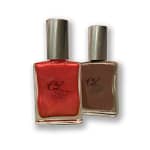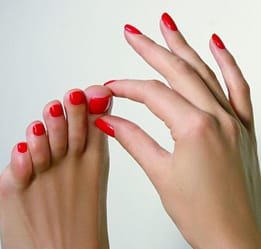Nail Polish “should you or shouldn’t you?”
Nail polish safety is an important topic not only for consumers but also for industry professionals. Nail polish dates to around 3000 BC in China, it was used in Egypt, and popularized by Revlon in the 1960’s. In today’s market they shimmer, shine, glow, glitter, and more all capture our attention.
First what is nail polish? It may seem like a little small bottle of color but it is so much more. It is a mixture designed to coat, stick, and shine on a nail bed.
Introducing Nail Polish
- Solvent – a liquid used to keep everything homogenous. Typical solvent is ethyl acetate
- Film Former – this allows for a smooth surface on the polish with the most common being nitrocellulose
- Resin – helps polish adhere to the nail bed but can also add depth, gloss, and may contribute to the hardness of the polish. Acrylate copolymers are just one example of the many used
- Plasticizer – This component reduces the attraction between polymers, like those contained in the resin, to make them less rigid. These adds flex to the polish which reduces cracking and chipping. Castor oil is but one additive used as a plasticizer.
- Thickeners – as the name implies this ingredient thickens the mixture allowing the thicker coat of polish to go on the nail. For example, Stearalkonium Hectorite actually causes some organic mixtures to gel thereby thickening the mixture. It is also aids in the dispersion of the solids into the liquids of the polish.
- UV Filters – these chemicals absorb both natural and artificial UV rays to prevent color degradation. Benzophenone-1 is the most widely known in polishes.

Nail polish is a suspension liquid, which is a liquid where there are solid particles held in suspension by the liquid molecules. This means that over time the solid parts, such as pigments, will separate from the liquid. This is why all polishes have a steel ball bearing in them so they can be adequately mixed back to its intended composition.
Since nail polish was popularized in the 1960’s many components thought safe have been proven otherwise. Product replacement has been a hot topic in many industries not just cosmetic and beauty products. The goal is to replace a hazardous ingredient with a much safer one.
Nail Polish Current Safety Trends

- Dibutyl Phthalate – originally used as a plasticizer but has been recently recognized as an endocrine disruptor. It interferes with hormone production and can affect the fertility in both males and females.
- Toluene – originally used a solvent but has been discontinued due the its affect on our central nervous system.
- Formaldehyde – Added to harden and strengthen the polish but has since been classified as a known human carcinogen by the IARC.
- Formaldehyde Resin – not a direct additive but rather a by-product of the natural polymerization of formaldehyde. It is a suspect skin irritant.
- Camphor – Once a very popular plasticizer it is now recognized as a poison to humans. It can be applied to intact skin to help with pain but if accidentally applied to cuts or breaks in the skin it can rapidly accumulate in the body.
- Xylene – This is a solvent similar to Toluene in its effects on the central nervous system of humans.
- Triphenyl Phosphate – Used as a plasticizer in polish. This ingredient is still used today but has come under recent suspicion of being a potential endocrine disruptor and possibly interferes with lipid metabolism. The science is still out on this one but a dose of caution may be best for you or your employees
- Parabens – Used as preservatives in many cosmetic products this is a known endocrine disruptor and has been linked to increases in breast cancer.
- Lead – Part of colored pigments used in the past. IARC has classified this as a probable carcinogen. It is known to cause developmental delays in children and anemia and brain damage in adults. It is known to affect the developing brain more so than the fully developed brain.
- Ethyl Tosylamide – Used as a plasticizer it has been linked to being a skin and respiratory irritant.
Nail Polish, Is it Safe?
The question of is it safe is always a difficult one to answer directly. For products like nail polish as well as current chemical processes ingredient replacement is one of the trends to improve safety. This is aimed at reducing exposure times to very 
Even though some of these ingredients may be used today as the science is still young on their effects, but here at Calla Lily all of our polishes are free from these toxic 10 ingredients. We offer over 40 colors that make up our classic line and 10 colors in our Blooming Beauty line specifically “crafted for adventurers”. They are child safe, cruelty free and vegan!
- The other thing to consider is ventilation. This is both for professionals and consumers alike. The better the ventilation, the less exposure to any chemical. Keeping this in mind will greatly improve the safety of nail polish for you, children and nail tech professionals.

